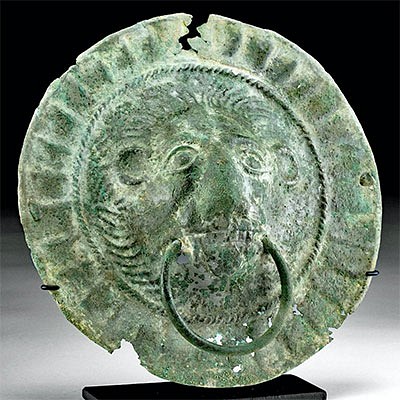20th C. African Bamana Wood ChiWara Ritual Mask
Lot 198
About Seller
Artemis Gallery
686 S Taylor Ave, Ste 106
Louisville, CO 80027
United States
Selling antiquities, ancient and ethnographic art online since 1993, Artemis Gallery specializes in Classical Antiquities (Egyptian, Greek, Roman, Near Eastern), Asian, Pre-Columbian, African / Tribal / Oceanographic art. Our extensive inventory includes pottery, stone, metal, wood, glass and textil...Read more
Estimate:
$800 - $1,200
Absentee vs Live bid
Two ways to bid:
- Leave a max absentee bid and the platform will bid on your behalf up to your maximum bid during the live auction.
- Bid live during the auction and your bids will be submitted real-time to the auctioneer.
Bid Increments
| Price | Bid Increment |
|---|---|
| $0 | $25 |
| $300 | $50 |
| $1,000 | $100 |
| $2,000 | $250 |
| $5,000 | $500 |
| $10,000 | $1,000 |
| $20,000 | $2,500 |
| $50,000 | $5,000 |
| $100,000 | $10,000 |
| $200,000 | $20,000 |
About Auction
By Artemis Gallery
Oct 14, 2021
Set Reminder
2021-10-14 10:00:00
2021-10-14 10:00:00
America/New_York
Bidsquare
Bidsquare : CLEARANCE | Ancient & Ethnographic Art
https://www.bidsquare.com/auctions/artemis-gallery/clearance-ancient-ethnographic-art-7705
Kick off fall with our clearance sale featuring discounted pricing and many new items! Asian art, Classical antiquities from Egypt, Greece, Italy, and the Near East...plus Pre-Columbian, Tribal, Russian Icons & Enamelware, Spanish Colonial, Fine Art, Fossils, more! Starting prices have been reduced Artemis Gallery info@artemisgallery.com
Kick off fall with our clearance sale featuring discounted pricing and many new items! Asian art, Classical antiquities from Egypt, Greece, Italy, and the Near East...plus Pre-Columbian, Tribal, Russian Icons & Enamelware, Spanish Colonial, Fine Art, Fossils, more! Starting prices have been reduced Artemis Gallery info@artemisgallery.com
- Lot Description
**Originally Listed At $650**
West Africa, Mali, Bamana (also Bambara or Banmana), ca. early 20th century. A beautiful example of a Chiwara (also Tji Wara), a ritual mask used by the Bamana people in dances and rituals. This horizontal, antelope-shaped carving, would have been perched atop a basketry base and worn with a raffia costume by a dancer. It features short, bent legs on a flat integral base, a long arched body with a raised tail embellished with painted hide and animal hair, a long neck wrapped in hide and strands of red glass beads, a large head with pointed ears, an open mouth with a revealed tongue, a tassel on the forehead, extremely long, curved horns, and twisted fiber strands, cowry shell, and a blue bead adorning the buttocks. Size: 14.9" L x 11.9" H (37.8 cm x 30.2 cm)
To the Bamana peoples, the antelope is regarded as a mythical being who taught humankind how to farm. The word tji means "work" and the word wara means "animal". Hence, tji wara means "working animal."
Provenance: ex-private Dr. Peter Horvath collection, Massachusetts and Florida, USA; ex-Old private New England, USA collection, acquired in the 1970s
All items legal to buy/sell under U.S. Statute covering cultural patrimony Code 2600, CHAPTER 14, and are guaranteed to be as described or your money back.
A Certificate of Authenticity will accompany all winning bids.
PLEASE NOTE: Due to recent increases of shipments being seized by Australian & German customs (even for items with pre-UNESCO provenance), we will no longer ship most antiquities and ancient Chinese art to Australia & Germany. For categories of items that are acceptable to ship to Australia or Germany, please contact us directly or work with your local customs brokerage firm.
Display stands not described as included/custom in the item description are for photography purposes only and will not be included with the item upon shipping.
#156725Fissure near tip of one horn, with small chips along break lines without adhesive. Abrasions and fading to brown pigment, with light encrustations in some recessed areas, and age-commensurate desiccation to fibrous components, and loosening to head atop neck. Fine, deep, oily, saturated, aged patina.Condition
- Shipping Info
-
All shipping is handled in-house for your convenience. Your invoice from Artemis Gallery will include shipping calculation instructions. If in doubt, please inquire BEFORE bidding for estimated shipping costs for individual items.
-
- Buyer's Premium



 EUR
EUR CAD
CAD AUD
AUD GBP
GBP MXN
MXN HKD
HKD CNY
CNY MYR
MYR SEK
SEK SGD
SGD CHF
CHF THB
THB














